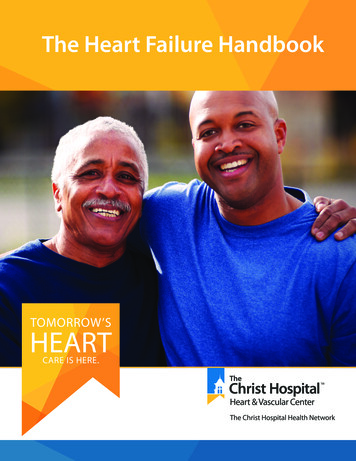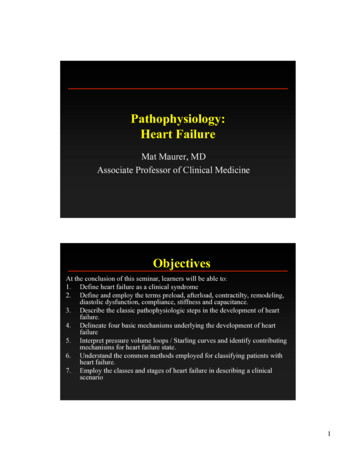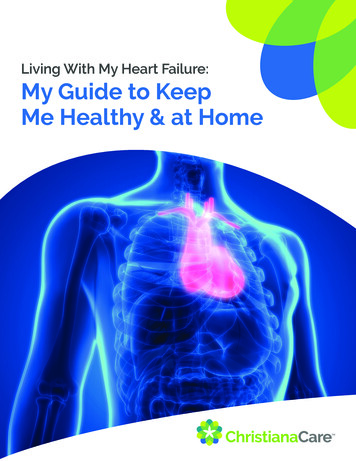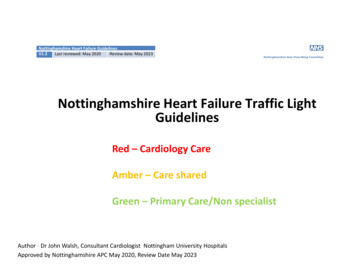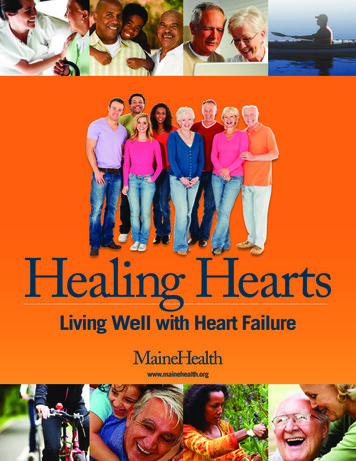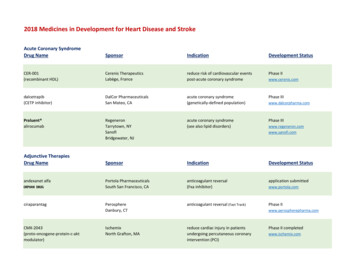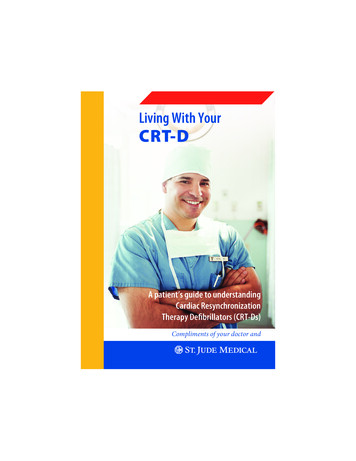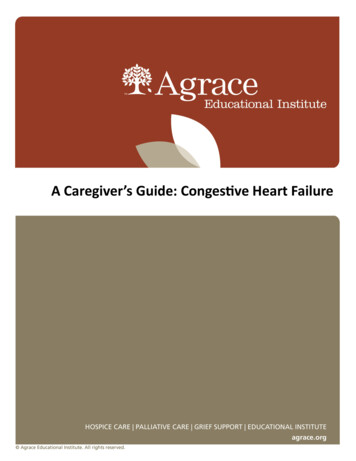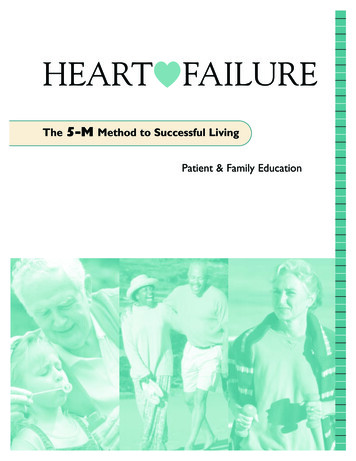
Transcription
HEART FAILUREThe5-M Method to Successful LivingPatient & Family Education
The 5-M Method to Successful Living WithHEART FAILURERecently your doctor has informed you that you have heartfailure.Though it may be shocking and frightening to hearthat your heart has grown weaker, there is no need for youto feel that your life need be less rewarding as a result.Successful living with heart disease is possible, but it meansthat you accept your state of health and that you activelymanage it every day.This booklet is your first step to living successfully withheart failure (HF). Here you will learn the “5-M Methodfor Successful Living with Heart Failure.”The 5-M’s cover the critical areas of your life that you needto attend to every day.They are:PAGEMESSAGE1MEDICINE3MEALS8MOVEMENT15MOOD18In addition, at the end of this booklet you will find theHF Personal Tool Kit.The HF Personal Tool Kit containshelpful charts, a glossary of terms, printed resources andWeb sites to help you learn to live successfully with HF.If you truly understand the nature of HF — the Message —you will find it easier to work with the other areas affectedby your condition (medicine, meals, movement and moods).So that's where you will begin — with the first M —Message.Successful Living With Heart Failure
MESSAGEMEDICINEMEALSMOVEMENTMOODYou begin the first steps to living successfully with heart failure(HF) by understanding your condition and how to manage it.What isHeart Failure?Though it may sound frightening at first, the term “heart failure”simply means that the heart has grown weak or enlarged. It doesnot mean the heart has stopped working or failed.Heart failure happens when the heart muscle becomes weakened orenlarged. The weak heart does not pump as strongly as before orprovide as much blood as the body needs. Fluid backs up in the lungs,stomach, legs, ankles and feet.This backup may make you feel short ofbreath, bloated or swollen in your stomach, legs, ankles or feet.You may experience more fatigue. Activities such as climbing stairs,raking leaves or walking the dog may now cause you to be short ofbreath or get dizzy or lightheaded.What are thesigns andsymptomsof HF?With HF you may have one or all of these symptoms: Unexpected and rapid weight gain (2-3 lbs. in 24 hrs. or 3-5 lbs.in a week) Weakness or fatigue Dizziness or faintness Swollen stomach, legs, ankles and feet (shoes and socks mayfeel tight) Dry cough when lying flat Unexpected shortness of breath. For instance, when you:– Are lying flat– Wake in the middle of the night– Perform routine activities Chest painThese symptoms may be mild or severe, depending on how weak theheart is and the underlying cause.1 – MessageSuccessful Living With Heart Failure
MESSAGEMEDICINEMEALSMOVEMENTMOODYou begin the first steps to living successfully with heart failure(HF) by understanding your condition and how to manage it.How do Imanagemy HF?Managing HF is a partnership between you and your healthcareclinician. Greatest success will come from: Checking your weight daily Reporting any sudden weight gain (2-3 lbs. in 24 hrs. or 3-5 lbs.in a week) Taking MEDICINE as directed Planning MEALS to avoid sodium Balancing MOVEMENT/activity with rest Living and learning from changing MOODS Monitoring signs and symptoms, and reporting them to your doctor Seeing your healthcare clinician regularly Seeking support from your family, friends and community resourcesFollowing these guidelines regularly will help you breathe easier,feel more comfortable, and enjoy more energy in all your activities.What kind ofmedical testsdo they dofor HF?The most common HF tests are: Blood tests — testing for electrolytes and kidney function Echocardiogram (or Echo) — a pain-free test that uses ultrasoundto show a moving picture of the heart in action and tells whatamount of blood the heart can pump with each beat Electrocardiogram (EKG or ECG) — a pain-free test that recordsthe electrical activity of the heart Chest X-ray — a pain-free test that produces a picture of theheart and lungsThese are the most common tests for HF; however, your healthcareclinician may order other tests depending on your condition.You will find a glossary of terms in the HF Personal Tool Kit at the back ofthis booklet.2 – MessageSuccessful Living With Heart Failure
MESSAGEMEDICINEMEALSMOVEMENTMOODYou need to take your heart medicine as ordered by yourphysician. It helps keep the heart functioning properly andminimizes the symptoms.Whatmedicineswill helpmy HF?Heart medicine is intended to improve and control HF but not cureit. Different HF patients have different medical needs. Your physicianwill prescribe the right medicine to help your HF.Some common heart medicines are: Vasodilators/ACE Inhibitors/ARBsThese drugs reduce blood pressure by helping the blood vesselsrelax and the blood to flow easier. DigoxinDigoxin helps the heart pump stronger and more regularly. Beta-blockersBeta-blockers help slow the heart rate.This improves pumpingaction and lowers blood pressure. DiureticsDiuretics rid the body of excess water or swelling from the lungs,stomach, legs, ankles and feet. (Diuretics may cause a potassiumloss, so food high in potassium or a potassium supplement maybe recommended.)3 – MedicineSuccessful Living With Heart Failure
MESSAGEMEDICINEMEALSMOVEMENTMOODYou need to take your heart medicine as ordered by yourphysician. It helps keep the heart functioning properly andminimizes the symptoms.Are there sideeffects to HFmedicines?Yes, there could be side effects experienced with HF medicine.Some possible effects are: Swelling of the face and/or tongue Difficulty breathing(If you experience either of the above side effects,seek medical attention immediately!) Lightheadedness, dizziness, fainting Skin rash or hives Headache Nausea, vomiting, diarrhea Dry cough lasting more than one month WeaknessWhat shouldIf you experience any side effects, contact your doctor.I do if IWrite your doctor’s telephone number here.experience anyside effects?DOCTOR’S PHONE �––––––4 – MedicineSuccessful Living With Heart Failure
MESSAGEMEDICINEMEALSMOVEMENTMOODYou need to take your heart medicine as ordered by yourphysician. It helps keep the heart functioning properly andminimizes the symptoms.I am takingseveralmedications.How can Iremember allthe names andtimes?Taking your HF medicine regularly is very important.To makeit easier, do the following: Know what medicine you are taking and what it does.Ask your healthcare clinician to give you a description of yourmedicine. Example: I am taking Coreg (carvezilol), a beta-blocker,to slow my heart down and lower my blood pressure. Have a routine for taking your medicine.Work with your healthcare clinician to set up a comfortableschedule and always follow dosage and frequency instructions. Make a list of your different medicines. Include each medicine’s name, purpose, dosage and how many times a day you havebeen instructed to take it. Put a copy of the list in your wallet orpurse. Don't forget to update the list if your medicine changes. Never take more medicine than prescribed. Always speakwith your healthcare clinician before changing the dosage orfrequency of your medicine.Then follow his or her instructionsfor best results. Never stop taking your medicine without instruction.Some medicines must be tapered off and not ended abruptly.Always ask your healthcare clinician. Ask before taking over-the-counter medicines, herbalremedies or vitamins. Some medicines and remedies, even vitamins, may weaken or conflict with your HF medicine. Check withyour healthcare clinician before taking any of these. Remember your medicine when you travel.For greatest success with medicine, you must take the right doseat the right time. Your routine changes when you travel, so it isespecially important to remember to stick to your schedule whileaway from home.5 – MedicineSuccessful Living With Heart Failure
MESSAGEMEDICINEMEALSMOVEMENTMOODYou need to take your heart medicine as ordered by yourphysician. It helps keep the heart functioning properly andminimizes the symptoms. Make a chart to help you remember all the informationabout your medicines. Your chart could look like the onebelow. Have your healthcare clinician help you fill in the spaces.Medicine Dosage and Time ChartDoctor’s Phone:Pharmacy Phone:At this time of dayName of MedicinePurpose of MedicineDosageBreakfastLunchDinnerBedtimeYou will find a sample chart in the HF Personal Tool Kit at the backof this booklet.Reminders:1. Always take medicine at the same time every day, even if you feelbetter.2. Never take any non-prescribed medication or remedy, even overthe-counter medicine, without first checking with your healthcareclinician.3. Consider reordering your medicine when you are down to a oneweek supply.4. Change your medicine chart whenever a medicine, dosage orfrequency changes.6 – MedicineSuccessful Living With Heart Failure
MESSAGEMEDICINEMEALSMOVEMENTMOODYou need to take your heart medicine as ordered by yourphysician. It helps keep the heart functioning properly andminimizes the symptoms.Medicine canbe expensive.What if I can’tafford it?Tell your healthcare clinician if you are unable to pay for medicine.Be sure to:1. Ask if there may be less expensive medicine that works justas well.2. Ask if there are community, state or federal financial resourcesavailable.7 – MedicineSuccessful Living With Heart Failure
MESSAGEMEDICINEMEALSMOVEMENTMOODYou need to limit sodium intake to 2,000 mg or less each day tolive successfully with HF.Why do Ineed toavoid salt?The foods you eat and the salt you use contain sodium. Sodium isthe element that causes your body to hold on to fluid.This extrafluid causes your heart to work harder to pump the extra fluid. Itcan also cause fluid to back up into your lungs, stomach, legs, anklesand feet.This fluid backup may cause you to feel short of breath anduncomfortable.How muchis 2000milligramsof sodium?2,000 milligrams of sodium equals about one teaspoon ofsalt. It also is the amount of sodium you would eat if you had atypical meal at a fast food restaurant.The following guide gives you an idea of the amount of sodium indifferent types of food.Where’s the Sodium?FOOD GROUPSBreads, CerealsCooked cereal, rice, pasta, unsaltedReady to eat cerealBreadFruitsFruits, freshFruits frozen, canned —VegetablesVegetables, freshVegetables, canned —cooked with or without saltVegetables, canned, or frozenwith sauceTomato juice, cannedTomato soup, canned —with milkVegetable soup, canned8 – MealsSuccessful Living With Heart FailureSODIUM, milligrams (mg)trace per 1/2 cup100–350 per oz.110–175 per slicetrace per 1/2 cupread food labeltrace per 1/2 cupread food labelless than 70 per 1/2 cup140–160 per 1/2 cup660 per 3/4 cup932 per cup810 per cup
MESSAGEMEDICINEMEALSMOVEMENTMOODYou need to limit sodium intake to 2,000 mg or less each day tolive successfully with HF.Where’s the Sodium? (continued)FOOD GROUPSMeat, Chicken, FishFresh meat, chicken, fishTuna, canned, water packBolognaHam, lean, roastedMilk,Yogurt, CheeseMilkYogurtNatural cheeses, such asCheddar or SwissProcess cheese, such asAmerican or SwissEgg, medium (whole)OtherSalad DressingCatsup, steak sauceSoy sauceSaltDill picklePotato chips, saltedCorn chips, saltedPeanuts, roasted in oil, saltedHow do Ilimit mysodium?SODIUM, milligrams (mg)less than 90 per 3 oz.300 per 3 oz.580 per 2 oz.1,025 per 3 oz.120 per cup170 per 8 oz.110–275 per 1-1/2 oz.790 per 2 oz.6980–220 per tbsp.180–230 per tbsp.1,020 per tbsp.2,000 per tsp.930 per 1 medium135 per oz.235 per oz.120 per oz.Here are some ideas for limiting your sodium intake: Remove the salt shaker from the table Purchase only low sodium food and drinks Use a sodium guide when preparing to eat, especially atrestaurants Read food labels on packaged goods when grocery shopping9 – MealsSuccessful Living With Heart Failure
MESSAGEMEDICINEMEALSMOVEMENTMOODYou need to limit sodium intake to 2,000 mg or less each day tolive successfully with HF.What will thefood label onpackagedgoods tell me?Food labels contain information vital to good health.They informyou about: Serving size Calories Amount of fat Amount of cholesterol Amount of sodium Amount of carbohydrates Amount of proteinLearning to read food labels will help you choose items with thelowest sodium content per serving size.The sodium content islisted on the food labelper serving size.Here is anexample ofa food label:Decreasing the totalamount of sodium youconsume to 2,000 mg(2 grams) or less eachday is one of the mostimportant ways tomanage heart failure.10 – MealsSuccessful Living With Heart Failure
MESSAGEMEDICINEMEALSMOVEMENTMOODYou need to limit sodium intake to 2,000 mg or less each day tolive successfully with HF.How do Ilimit mysodium wheneating at arestaurant?It is a challenge to limit sodium intake when eating at restaurants,especially fast food restaurants. But here are a few ideas you canstart to use: Never add salt to your food Read the entire menu. Restaurants sometimes offerlow-sodium or sodium-free alternatives. Ask the waitperson. He or she may know of the low-sodiumor sodium-free offerings, or he or she may ask for your food tobe prepared without salt. Call the restaurant first and ask if they have low-sodiumalternatives on their menu. Use a sodium guide. Many fast food restaurants publish thenutritional values of their products, but you will probably haveto ask for it.How do I limitmy salt whencooking?Here are some easy things to do when cooking: Stop automatically adding salt to cooking water whenpreparing any food Use less salt than a recipe calls for or eliminate it entirely Decrease the use of prepared foods like soups, instantcereals, lunchmeats and frozen entrees Use herbs, spices and other fresh ingredients asseasoning for meat, fish and vegetables11 – MealsSuccessful Living With Heart Failure
MESSAGEMEDICINEMEALSMOVEMENTMOODYou need to limit sodium intake to 2,000 mg or less each day tolive successfully with HF.How do Iplan mymeals?Planning meals requires that you note the amount of sodium in thefoods you want to eat.Then limit either the quantity of food or thetype of food to stay within the goal of 2,000 mg of sodium or lesseach day.Hint: Choose foods with lower amounts of salt for breakfast toallow for more food choices at other meals.Here is a sodium intake chart.This type of chart helps you measureyour total intake of sodium every day for a week.1. Calculate the amount of sodium you eat daily during each timeperiod.2. Add the amounts in each time period for your total daily intake.Sodium Intake ChartIdeal Sodium Intake is 2,000 mg/day or lessDay6:00 a.m. – 2:00 p.m.2:00 p.m. – 10:00 p.m.10:00 p.m. – 6:00 a.m.Total Sodium Intake aySundayYou will find a larger version of this chart in the HF Personal Tool Kitat the back of this booklet.12 – MealsSuccessful Living With Heart Failure
MESSAGEMEDICINEMEALSMOVEMENTMOODYou need to limit sodium intake to 2,000 mg or less each day tolive successfully with HF.Which typesof food areacceptableand whicharen’t?The following chart will give you an idea of what foods you shouldfavor and what you should avoid.FOOD DO’SFOOD DON’TSDairyMilk (1%, skim or powdered)Low fat or skim milk Ricotta,Mozzarella or Swiss cheeseDairyButtermilk, malted milkCanned milkCommercially prepared buttermilkEgg substituteRegular hard & processed cheeseCheese spreads and saucesSnack dips made from instantsoup mixMeat, Poultry, FishChicken or turkeyLean cuts of beef, veal or lambCanned tuna and salmon(unsalted or rinsed)Fish, fresh or frozen (unbreaded)Beef tongueMeat, Poultry, FishCanned meatsCanned fish (sardines, unrinsed tuna,and salmon)Cured meats (dried beef, bacon orcorned beef)All types of sausages (beef, pork,chicken, turkey, Polish, hot dogs,knockwurst, bratwurst, etc.)Sandwich meatsAny cured, koshered or canned meat,fish, poultryBreads, Cereals, GrainsPotatoes, rice or pasta cookedwithout saltEnriched breads and rollsUnsalted cooked cerealMost dry cerealsUnsalted crackers and breadsticksBreads, Cereals, GrainsCommercially prepared potato, rice,pasta or stuffing mixCommercially prepared mixes(pancake, waffle, muffin, cornbread)Salted nutsVegetablesFresh, frozen or low-sodium cannedVegetablesRegular canned or pickled vegetablesSauerkraut13 – MealsSuccessful Living With Heart Failure
MESSAGEMEDICINEMEALSMOVEMENTMOODYou need to limit sodium intake to 2,000 mg or less each day tolive successfully with HF.FOOD DO’SFOOD DON’TSFruitFresh or frozen(no sauce or plastic pouches)Canned (unsalted/low-sodium)FruitDrinksFruit juices, fresh and frozen canned(low-sodium)Instant breakfast drinkLemonadeTea, coffeeDrinksTomato and vegetable juiceSports/athletic drinks (Gatorade)Fats, OilsMayonnaiseButter or margarine (unsalted)Canola, olive, corn, cottonseed,peanut, safflower, soybean andsunflower oilFats, OilsSalted butter or margarinePeanut butterSalted nutsSnacksChipsSweetsInstant pudding and cake mixesStore-bought pies, cakes, muffinsSeasoningYou can use pepper, herbs, spices,vinegar, lemon juice, hot pepper andmustardSeasoningAny seasoning made with salt such asgarlic salt or onion salt, meat tenderizers, MSG, regular barbecue or soysauce, canned gravy and mixes,regular condiments, and olivesCheck with your doctor about using a salt substitute.14 – MealsSuccessful Living With Heart Failure
MESSAGEMEDICINEMEALSMOVEMENT MOODYou need to remain active to live successfully with HF. Not onlyis movement necessary for healthy living — so is rest.Why can’t Iget by on anight’s sleepanymore?Why do I getso tired?Living successfully with HF means learning to enjoy both activityand rest. Quieter activities and more frequent rest periods may benecessary for optimal heart function and to manage symptoms.With HF, the heart is not as efficient as it used to be, so it needsmore help to do its work. You help your heart by resting moreoften to let the body eliminate the fatigue that builds up while youare active. Balancing your activity with rest will help you: Feel better Sleep better Minimize your symptoms (shortness of breath, dizziness, fatigue,even chest pain) Accomplish moreIs balancingactivity withrest somethingI can plan inadvance?Yes. Your planning should include several things: Identify restricted activities, if any.Your doctor may have told you to avoid certain kinds of activities, like driving, climbing stairs, etc. So think ahead about whatyou want to do and plan around those kinds of activities. Organize the day into activity periods and rest periods.By alternating activity with rest, you will get more done whilefeeling better doing it. Monitor your symptoms during the day.Learn to improve your awareness of your body. Make a habit ofpaying attention to your breathing, your heart rate, the feeling inyour lungs, stomach, legs, ankles and feet.15 – MovementSuccessful Living With Heart Failure
MESSAGEMEDICINEMEALSMOVEMENT MOODYou need to remain active to live successfully with HF. Not onlyis movement necessary for healthy living — so is rest.How do Ibalanceactivity andrest?Activity and Rest ChartACTIVITIESREST Choose lighter activities, suchas walking, shopping, less activehobbies (sewing, bird watching,model building, movies, bookdiscussion groups, Internet surfing,card-playing, etc.). Rest before you get tired. Pace activity and rest during theday, resting frequently to avoidgetting tired. Rest if you are tired orexperiencing pain. Rest for 15 to 20 minutes afteractivity. Rest one hour after meals. Don’t lift heavy objects or strainto reach things. When resting, put your feet up tohelp reduce swelling of the legs,ankles and feet. Avoid temperature extremes.Being too cold or hot places extrastress on the heart. As you begin to feel stronger,lengthen your activity periods andshorten your rest periods. Adjust your routine to avoidinclement weather. Stand and sit down slowly to avoidlightheadedness.You will find a sample chart in the HF Personal Tool Kit at the backof this booklet.16 – MovementSuccessful Living With Heart Failure
MESSAGEMEDICINEMEALSMOVEMENT MOODYou need to remain active to live successfully with HF. Not onlyis movement necessary for healthy living — so is rest.What isthe best planto balanceactivity andrest?1. Identify activity restrictions, if any.2. Organize the day into many periods of activity and rest.3. Monitor your symptoms.When to call your doctorDoctor’s PhoneSTOP and REST if your physical activity brings on any of thesesymptoms: Shortness of breath Palpitations or the heart is racing Extreme tiredness and fatigue Lightheadedness or dizziness Sudden weight gain — 2-3 lbs. in 24 hrs. or 3-5 lbs. in a weekWhen to call 911If you have chest pain:STOP ACTIVITY.Take angina medicine as directed.If pain does not go away or you have extreme shortnessof breath, this is a medical emergency.Call 911.17 – MovementSuccessful Living With Heart Failure
MESSAGEMEDICINEMEALSMOVEMENTMOODYou need to accept HF as a permanent part of your life and do allyou can to live fully.How am I evergoing to dealwith heartfailure?Living with HF is not only a physical adaptation but also anemotional adjustment. Everyone experiences a wide range ofnormal emotions when they are told they have HF.What is thenormal rangeof emotion?How do otherpeople feelwhen theyhear theyhave HF?People report a wide range of emotions when they are told they haveHF. Your emotions will change over time, and sometimes you may notbe able to control them. If, instead of trying to control them, you identify and work with your emotions, you will take a giant step to acceptliving with HF.You may experience different emotions: Loss – feeling that you will never perform as you once did. “My lifewill never be the same.” Denial – prevents you from admitting or accepting that somethingis wrong. “That’s ridiculous. I feel fine.That can’t be happening to me.” Anger – frustration that you cannot have it your way. “You don’tknow what you’re talking about. You don’t know a thing about me.” Sadness – feeling that you are missing something you need. “I missplaying golf with all my friends.” Fear – feeling afraid of failure, loss or pain. “I am afraid to move.I keep thinking something awful may happen.” Guilt – feeling that in some way you are responsible for causingyour condition. “I knew my diet was bad. How could I have continuedthe way I did?” Acceptance – when you have experienced and worked throughthe other emotions. “That was then and this is now. I have to thinkabout the future. I can change my habits and live my life the bestI can.”18 – MoodSuccessful Living With Heart Failure
MESSAGEMEDICINEMEALSMOVEMENTMOODYou need to accept HF as a permanent part of your life and do allyou can to live fully.How do I workthrough theseemotions andaccept HF?You may prefer to keep your feelings to yourself, but it is very difficult to work through these feelings alone. It can be helpful to talkabout your concerns and feelings with others. Share how you feelabout HF with trusted family and friends.This is a hard period ofadjustment.They will understand and want to help. If you have difficulties sharing your moods with family or friends, you should speakwith your healthcare clinician.If you feel overwhelming sadness or despair, or feel that the challenges of HF are too much, and these feelings extend more thantwo weeks, you could be experiencing depression and you shouldcontact your healthcare clinician.Are thereHF supportgroups?Yes.There are many support groups for those with HF and theirfamilies. Support groups offer members the opportunity to: Share their own feelings and experiences about living with HF Hear the other people’s experience about life with HF Hear about current HF research findings Receive articles from the general press about HF Listen to experts and guest speakers on HFSpeak with your doctor, nurse or primary care physician to getinformation about local HF support groups or contact: The American Heart Association (phone 1-800-242-8721 or onthe Internet at www.americanheart.org) Ask your care provider for your hospital’s Web site address19 – MoodSuccessful Living With Heart Failure
MESSAGEMEDICINEMEALSMOVEMENTMOODYou need to accept HF as a permanent part of your life and do allyou can to live fully.What shouldI do on a dailybasis to manage my HFcondition?There are several things to do daily to manage HF. The followingchart identifies those tasks and provides an excellent HF history foryour healthcare clinician.Daily Management ChartDayDateWeightSodium IntakeSymptoms/Daily ActivitiesSpecial Needs (i.e., blood SundayInstructions:1. Write in the date.2. Weigh yourself when you get up in the morning and enter your weight.3. Record your sodium intake for the day.4. Write down any symptoms you experienced during the day.5. Describe your activities, including rest periods, during the day.6. Comment or record individual needs (i.e., blood sugar).Also: If you gain 2-3 lbs. in 24 hrs. or 3-5 lbs. in a week,call your healthcare clinician. Bring copies of this chart to your appointmentswith your healthcare clinician.You will find a copy of this chart in the HF Personal Tool Kit at the backof this booklet.1. Write in the date.2. Weigh yourself when you get up in the morning and enter your weight.3. Record your diet and sodium intake for the day.4. Write down any symptoms you experienced and describe youractivities, including rest periods, during the day.5. Write down any other information suggested by your healthcareclinician.ALSO: If you gain 2-3 lbs. in 24 hrs. or 3-5 lbs. in a week, call your healthcareclinician. Bring copies of this chart to your appointments with your healthcareclinician.20 – MoodSuccessful Living With Heart Failure
HEART FAILUREPERSONAL TOOL KITINCLUDED:Medicine Dosage and Time ChartSodium Intake ChartActivity and Rest ChartDaily Management ChartGlossary
Name of MedicinePurpose of MedicineDosagePharmacy Phone:Doctor’s Phone:BreakfastLunchDinnerAt this time of dayBedtimeMedicine Dosage and Time Chart
Day6:00 a.m. – 2:00 p.m.2:00 p.m. – 10:00 p.m.10:00 p.m. – 6:00 a.m.Total Sodium Intake (mg/day)Ideal Sodium Intake is 2,000 mg/day or lessSodium Intake Chart
Doctor’s PhoneSTOP and REST if your physical activity brings onany of these symptoms: Shortness of breath Palpitations or the heart is racing Extreme tiredness and fatigue Lightheadedness or dizziness Sudden weight gain — 2-3 lbs. in 24 hrs. or 3-5 lbs.in a weekWhen to Call the Doctor Choose lighter activities, such as walking, shopping,less active hobbies (sewing, bird watching, modelbuilding, movies, book discussion groups, Internetsurfing, card-playing, etc.). Pace activity and rest during the day, restingfrequently to avoid getting tired., Don t lift heavy objects or strain to reach things. Avoid temperature extremes. Being too cold or hotplaces extra stress on the heart. Adjust your routine to avoid inclement weather. Stand and sit down slowly to avoid lightheadedness.ActivitiesCall 911.If pain does not go away or you have extremeshortness of breath, this is a medical emergency.Take angina medicine as directed.STOP ACTIVITY.If you have chest pain:When to Call 911Rest before you get tired.Rest for 15 to 20 minutes after activity.Rest one hour after meals.Rest if you are tired or experiencing painWhen resting, put your feet up to help reduceswelling of the legs, ankles and feet. As you begin to feel stronger, lengthen your activityperiods and shorten your rest periods. RestActivity and Rest Chart
DateWeightSodium IntakeSpecial Needs (i.e., blood sugar) Bring copies of this chart to your appointmentswith your healthcare clinician.Also: If you gain 2-3 lbs. in 24 hrs. or 3-5 lbs. in a week,call your healthcare clinician.Symptoms/Daily ActivitiesInstructions:1. Write in the date.2. Weigh yourself when you get up in the morning and enter your weight.3. Record your sodium intake for the day.4. Write down any symptoms you experienced during the day.5. Describe your activities, including rest periods, during the day.6. Comment or record individual needs (i.e., blood yMondayDayDaily Management Chart
HF Personal Tool Kit Glossary of TermsACE InhibitorsMedicine that reduces blood pressure by allowing the bloodto flow easier.Blood PressureThe pressure exerted by circulating blood on the walls of thearteries, veins and chambers of the heart.Beta-blockerMedicine that slows the heart rate, improves the pumpingaction and lowers the blood pressure.CalorieA unit of measurement used to describe the amount of bodyenergy produced by food breakdown.CarbohydrateAny groups of organic compounds, the most important beingsugar and starch.Chest-X-rayA diagnostic procedure which produces a photographic imageof the chest.CholesterolA fat-soluble steroid found in animal fats, oils and egg yolks.It is produced by the liver and is widely distributedthroughout the body.DepressionA mood disturbance characterized by feelings of sadness,despair and discouragement.DiureticA drug which increases the formation of urine.EchocardiogramA diagnostic procedure which shows the structure andmotion of the heart.Electrocardiogram(EKG) or (ECG)A wavelike graphic record produced by an electric currentwhich is generated by the heartbeat.ElectrolyteAn element in the body, which turns into ions and is ableto conduct electrical current.
HF Personal Tool Kit Glossary of Terms(continued)FatA substance composed of lipids or fatty acids and foundin the body.Gram (g)A unit of mass in the metric system equal to 1/1000 of akilogram.Healthcare Clinician A p
Successful Living With Heart Failure Though it may sound frightening at first,the term "heart failure" simply means that the heart has grown weak or enlarged.It does not mean the heart has stopped working or failed. Heart failure happens when the heart muscle becomes weakened or enlarged. The weak heart does not pump as strongly as before or
